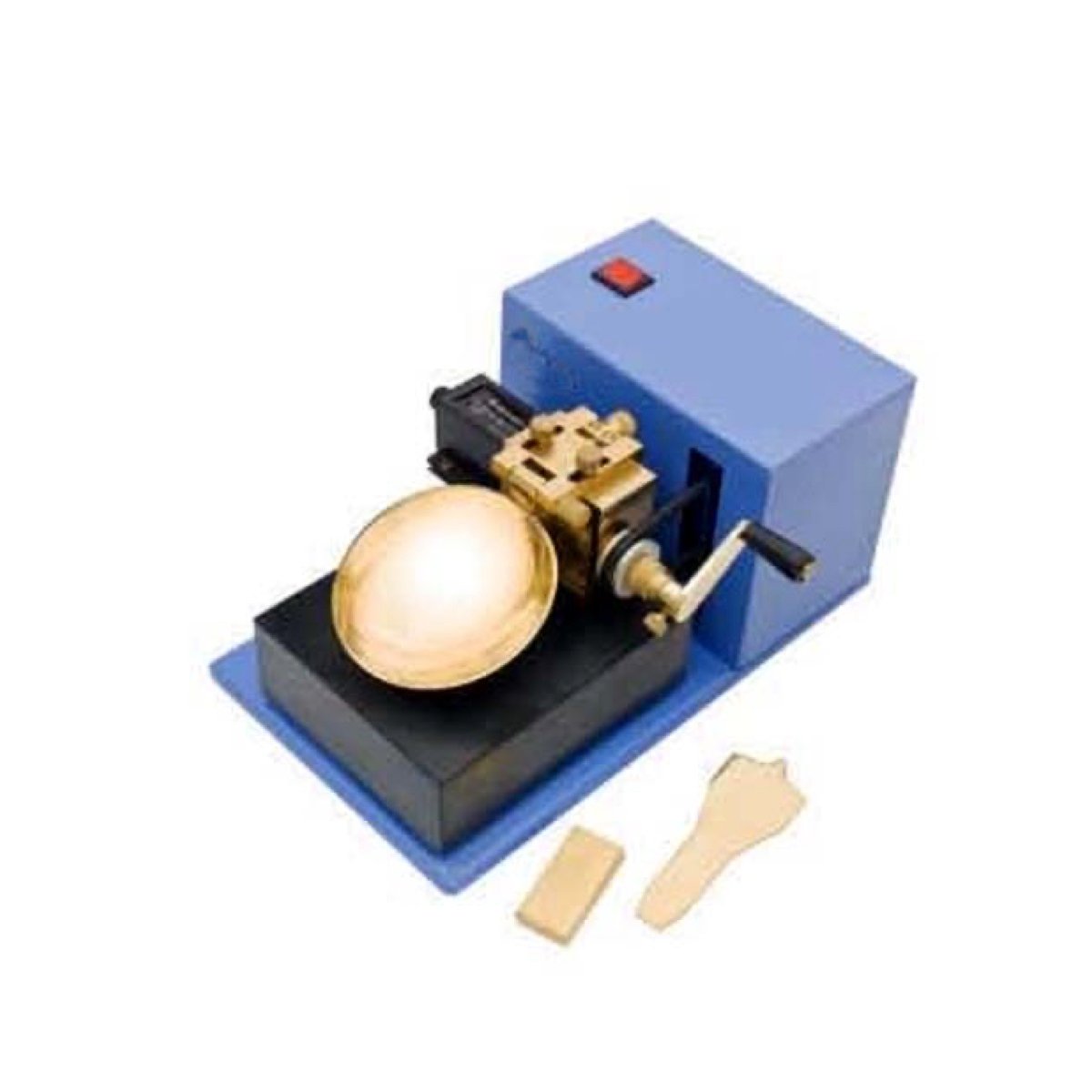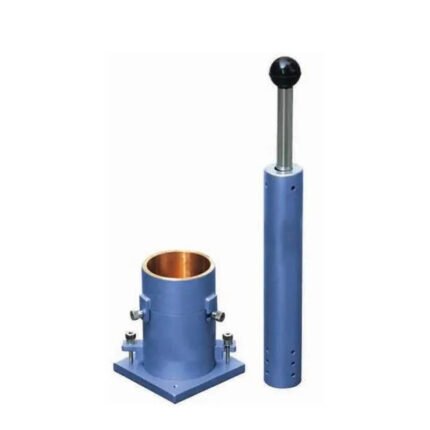AZA 0854 LIQUID LIMIT DEVICE (MOTORISED)
Same as AZA 0853 but fitted with a motor geared down to give
approximately 120 rpm. Suitable for operation on 230 V A.C.,
Single Phase, 50 Cycles.
Spares :
Casagrande grooving tool. ASTM grooving tool, height block,
1cm high.
Category: Soil
Related products
AZA 0849 SHRINKAGE LIMIT SET
IS 2720 (PART-VII) ASTM D 427, BS 1377, AASHTO T 92. Shrinkage limit is the maximum water content at which a reduction in water content does not cause an appreciable reduction in volume of the Soil Mass. At shrinkage limit, on further reduction in water, air enters in to the voids of soils and thus keeps the volume constant.
The apparatus can be used to determine shrinkage limit and to calculate other shrinkage ratio, shrinkage index and volumetric shrinkage.
Set consists of one each:
1. Porcelain evaporating dish
2. Shrinkage dish
3. Glass cup
4. Perspex plate with three metal prongs
5. Flexible spatula 100mm
6. Glass cylinder
7. 25ml x 1ml, supplied without mercury
6. Plastic wash bottle 500ml
Optional Accessories:
Mercury supplied in bottle of 500 gms. at an extra cost.
AZA 0853 LIQUID LIMIT DEVICE WITH COUNTER
IS 2720 (PART V), BS 1377-2 , ASTM D 4318
Specification:
Casagrande method in mechanical form is known as liquid limit method and has been in use for soil mechanics for a
number of decades. The liquid limit data of soils is useful to correlate mechanical properties of soil, such as
compressibility and lower shear strength. Liquid limit is the water content at which soil passes from zero strength to an
infinite strength, hence the true value of liquid limit cannot be determined.
For determination purpose liquid limit is that water content at which a part
of soil, cut by a groove of standard dimensions, will flow together for a
distance of 1.25cm under an impact of 25 blows in a standard liquid limit
apparatus. The soil at the water content has some strength which is about
0.17N/cm. sq. (17gms/sq.cm.) . At this water content soil just passes
from liquid state to plastic state.
It consists on a brass cup held on an adjustable bracket.
The cup can be adjusted for a fall of 1 cm and can be raised an dropped
on a rubber base of standard hardness by cam action. Complete with one
Casagrande grooving tool, one ASTM grooving tool and a height gauge
block. A counter to register the number of blows.
AZA 0856 GRAIN SIZE ANALYSIS (PIPETTE METHOD)
IS 2720 (PART IV) AND BS 1377:2.
Specification:
This is for the determination of the sub sieve particle distribution in a
soil sample by mechanical analysis. An analysis of this kind
expresses quantity the proportions by weight of the various sizes of
particles present in the soil. It is recommended as a standard
procedure to use dispersion agent to avoid flocculation.
The apparatus consists of a sliding panel which moves up and
down by means of a screw allowing Anderson pipette fixed to it to
be raised or lowered vertically. A sedimentation tube is held by a
laboratory clamp provided on the stand below the pipette. The
depth of immersion is measured by a scale graduated in mm at the
side of the sliding panel. Supplied complete with Anderson pipette
10ml. At the side capacity made from glass, and a sedimentation
tube also of glass of 500ml capacity and 50nos. Test form pads.
Accessories & Spares: (on extra cost)
1) Sedimentation Pipette (Anderson pipette) 25ml.
2) Sedimentation tube 100ml
3) Sedimentation pipette 10ml
4) Sedimentation tube 500ml
5) Test forms pad of 50
AZA 0862 PLUMMET BALANCE
Conventionally particle size distribution analysis is carried out using pipette and
hydrometer methods. Whereas in hydrometer method it is possible to determine
particle sizes in the range 75microns, the method involves computation and it is
time consuming. The pipette method can be used for determining only the
percentage of specific sizes less than 0.02, 0.006 and 0.002mm as a percentage
of total soil sample.
The plummet balance method to determine sub sieve particle size for the entire
range is very rapid and only manipulation of height of the balance, so that plummet
sinks to the right depth is required.
The percentage of soil in suspension is directly indicated by a pointer over a
graduated scale.
A vertical rod is mounted on a sturdy base having leveling screws.
A pointer with steel pivots turns is jewel bearing an moves over a graduated scale.
Scale graduations are market 0-100% x 2%
To the other end of the pointer a plummet is hanged. Rack and pinion arrangement is provided on the vertical rod for
adjusting the height. Supplied with a chart showing relationship between “K” and temperature of suspension of
soils of varying specific gravity from 2.4 to 2.8 to help in solving stroke's equation. Supplied complete with one
Perspex plummet one measuring jar and one rider weight for zero adjustment and rider weight for adjusting the
pointer to 100%.
AZA 0866 HEAVY COMPACTION TEST
IS 2720 (PART-VIII)
Specification:
Instrument consists one each of compaction
mould steel 150 mm I.D. x 127.3mm height
volume 2250cc. Complete with collar and
base plate. Compaction Rammer is 4.89
kgs. in weight x 450 mm controlled fall.
Note : Instead of steel moulds, gunmetal
mould are also available.
AZA 0871 WATER LEVEL INDICATOR
AZA 0871 A Water level indicator 50 m cable length
AZA 0871 B Water level indicator 100 m cable length
AZA 0871 C Water level indicator 150 m cable length
AZA 0871 D Water level indicator 200 m cable length
The water level indicators (electric contact meters) are portable, easy-to-use and reliable
instruments for measuring water level and total depth in bore holes, wells, observation
pipes, reservoirs, as well as control of pumping tests.
As soon as the measuring probe electrode touches the water surface, the signal indicator
on the instrument lights up with an audible alarm. The water level can be read on the
measuring tape in meters (m) and centimeters (cm).
Technical Specifications:
Measuring Range 50m, 100m, 150m, 200m
Accuracy 1 cm for a Measuring Range of 100m
Reproductibility 0.5 cm
Pressure Tightness 10 Bar (up to 50 Var Possible)
Probe Chromium-plated Brass
Standart Version 14 mm Dia. 140 mm Long
Special Version 10 mm Dia. 320 mm Long
Cable Polyethylene with 2 steel cores (Anti-corrosive) with Polyamide-coated steel tape,
Graduation in millimeters (mm), in centimetres (cm) and numbering in decimetres
In black color, the meters (m) figures are red colour on yellow-green base
Cable Drum Hard Rubber, Plastic Material and Temperature Resistant
Power Supply 3v DC.2 Baby-cells each 1.5v
AZA 0872 DYNAMIC CONE PENETROMETER
A simple and robust instrument for rapid in-situ measurement of the structural properties of road pavements
! Provides fast and efficient method of obtaining information
! For continuous measurements up to a depth of 800 mm and 1,200 mm with the extension rod.
! Portable and can be accommodated in a carrying case
for pavement design. Agreement is generally good over most of the range but differences are apparent at low values of
CBR, especially for fine grained materials.
It incorporates a 8 Kg weight dropping through a height of 575 mm and a 60 deg. cone having a diameter of 20 mm.
It is supplied complete with assembly tools and weighs 20 Kg approx.
The DCP needs three operators, one to hold the instrument, other to raise and drop the weight and a technician to
record the results. The instrument is held vertically and the weight carefully raised to the handle limit and then allowed
to fall onto the anvil.
The equipment consist of the following replaceable parts
AZA 0872A Top and Bottom Rod
AZA 0872B Handle
AZA 0872C Hammer
AZA 0872D 1m Scale
AZA 0872E 60 deg. Cone
AZA 0872F Anvil
AZA 0876 PERMEABILITY APPARATUS (FALLING HEAD PERMEABILITY)
IS 2720 (PART XVII) 1966.
The apparatus is used for the laboratory determination
of permeability of soil using a constant or a variable
head. This test is recommended for soils with co-effcient
permeability in the range of 0-10-3 to 10-7 cm/sec. The
maximum particle size of the soil which can be tested in
the mould is 10mm.

 Rock
Rock Aggregate
Aggregate Cement
Cement Concrete
Concrete Soil
Soil Steel
Steel Bitumen/Asphalt
Bitumen/Asphalt Security Survey Equipment
Security Survey Equipment General Items
General Items











